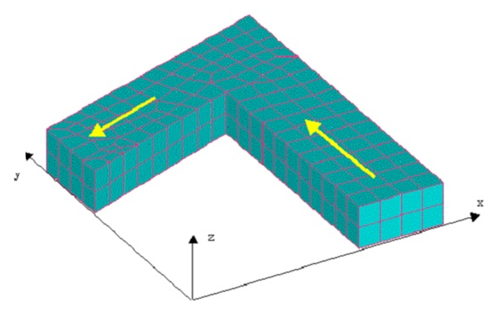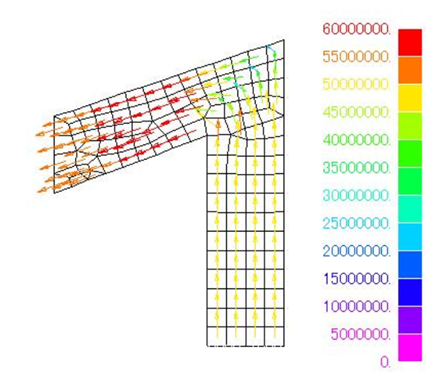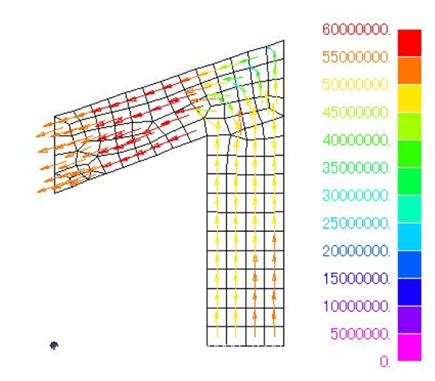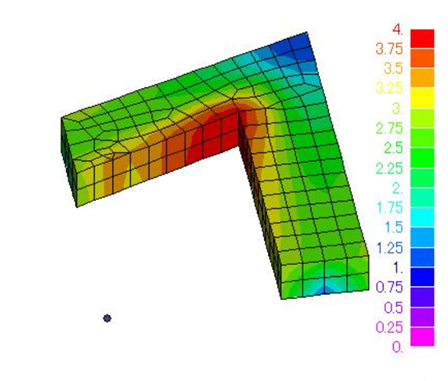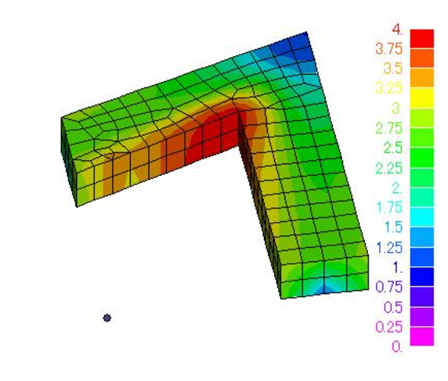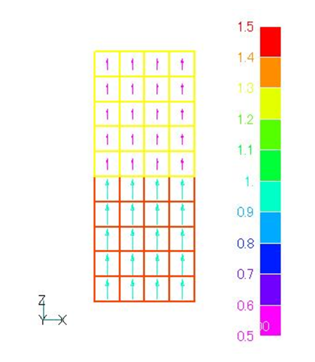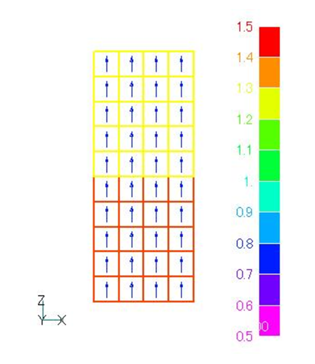Regularization of SDEFCOIL (surface-defined current source)
- TOP >
- Analysis Examples by Functions (List) >
- Regularization of SDEFCOIL (surface-defined current source)
Summary
In EMSolution, by using "SDEFCOIL (Surface Defined Current Source)", it is possible to input a current source that has a nearly uniform current density in the cross section for a rectangular cross-section coil. This source can strictly eliminate current divergence. However, note that this condition may not be strictly satisfied when the periodic symmetry condition is used, and so the ICCG method may diverge.
For example, with a model like Fig. 1, if the calculation is performed under 90-degree periodic symmetry conditions, the convergence of the ICCG method will only reach to about 0.02. The mesh is, of course, matched at x = 0 and y = 0 if it is completely rotated 90 degrees. However, the coil shape is not symmetrical on the x-axis side and the y-axis side. The cause of the divergence is that the continuity of the current is not satisfied due to the difference between the potential distributions that determine the current density on the x = 0 and y = 0 planes. Even if the mesh is made symmetrical with respect to 45 degrees, some degradation of divergence can occur due to the numerical error included in these potentials, although the convergence is slightly improved.
For example, when the residual becomes small to be about $10^{-5}$, there is no problem (the convergence is enough), but considering nonlinear calculation etc, you may wish to make the convergence better.
Explanation
Therefore, we have made it possible to perform regularization similar to the case of COIL (external current magnetic field source). The analysis method allocates the scalar potential in the coil, finds the potential so as to satisfy the continuous current condition, and corrects it.
Figures 2 and 3 show the coil current distribution before and after regularization correction. After the correction, the uniformity in the coil cross section is slightly lost, but the continuity of the current is improved. When corrected, it converged to the specified $10^{-10}$.
Figures 4 and 5 are the results of static magnetic field analysis executed with and without correction. It can be said that there is no problem with the result without correction, which does not change much in appearance and converges only to about 0.02. However, if regularization is not performed, the convergence of the nonlinear calculation can only be achieved to this extent during the nonlinear calculation, which is a problem. It is also a problem when seeking a response to very small fluctuations.
The point to note when using this function is that discontinuous currents are also averaged. For example, if a discontinuous current (upper 0.5$A/m^2$, lower 1$1A/m^2$) is forcibly applied as shown in Fig. 6 (a) and regularization correction is performed, the average is shown as shown in Fig. 6 (b). The converted current of 0.75$A/m^2$ will flow. Therefore, if a current with a large discontinuity is input, the analysis will be such that the specified coil current does not flow. If regularization correction is applied, the ICCG method will converge even if the current is discontinuous. Since regularization is a correction, it is necessary to define the coil so that the continuity of the current is satisfied as much as possible. For confirmation, perform the analysis once without regularization and confirm that the ICCG method converges to some extent. If it does not converge at all, it is expected that there is a large discontinuity in the current. In addition, it is important to check the corrected coil current distribution.
Fig.6 Current distribution before and after regularization correction of linear coil
You may wish to fix the total amount of current flowing through the cross section, but this will be an issue for the future. This regularization technique can also be applied to other current specifications.
Please use it when the ICCG method does not converge sufficiently and diverges in case of the current magnetic field sources "ELMCUR (Internal Current Source)", "SDEFCOIL (Surface Defined Current Source)" and source input in "Static magnetic field analysis using COIL (external current magnetic field source)".
The rest of this page is for members only.
Analysis Examples by Functions
Static magnetic field
- Static magnetic field analysis using ELMCUR (element current source)
- Static magnetic field analysis using SDEFCOIL (surface defined current source)
- Regularization of SDEFCOIL (surface-defined current source)
- Static magnetic field analysis using PHICOIL
- Static magnetic field analysis using COIL (external current magnetic field source)
- Non-linear static magnetic field analysis
©2020 Science Solutions International Laboratory, Inc.
All Rights reserved.


